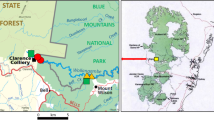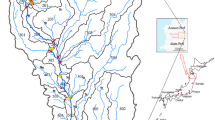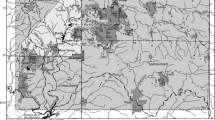Abstract
Globally, thousands of kilometres of rivers are degraded due to the presence of elevated concentrations of potentially harmful elements (PHEs) sourced from historical metal mining activity. In many countries, the presence of contaminated water and river sediment creates a legal requirement to address such problems. Remediation of mining-associated point sources has often been focused upon improving river water quality; however, this study evaluates the contaminant legacy present within river sediments and attempts to assess the influence of the scale of mining activity and post-mining remediation upon the magnitude of PHE contamination found within contemporary river sediments. Data collected from four exemplar catchments indicates a strong relationship between the scale of historical mining, as measured by ore output, and maximum PHE enrichment factors, calculated versus environmental quality guidelines. The use of channel slope as a proxy measure for the degree of channel-floodplain coupling indicates that enrichment factors for PHEs in contemporary river sediments may also be the highest where channel-floodplain coupling is the greatest. Calculation of a metric score for mine remediation activity indicates no clear influence of the scale of remediation activity and PHE enrichment factors for river sediments. It is suggested that whilst exemplars of significant successes at improving post-remediation river water quality can be identified; river sediment quality is a much more long-lasting environmental problem. In addition, it is suggested that improvements to river sediment quality do not occur quickly or easily as a result of remediation actions focused a specific mining point sources. Data indicate that PHEs continue to be episodically dispersed through river catchments hundreds of years after the cessation of mining activity, especially during flood flows. The high PHE loads of flood sediments in mining-affected river catchments and the predicted changes to flood frequency, especially, in many river catchments, provides further evidence of the need to enact effective mine remediation strategies and to fully consider the role of river sediments in prolonging the environmental legacy of historical mine sites.








Similar content being viewed by others
References
Allan R (1997) Introduction: mining and metals in the environment. J Geochem Explor 58:95–100
Alpers CN, Hunerlach MP, May JT, Hothem RL (2005) Mercury contamination from historical gold mining in California. United States Geological Survey, Sacremento, p. 6
Bearcock JM, Perkins W (2007) The use of green rust to accelerate precipitation of ochre for mine water remediation. In: Cidu R, Frau F (eds) IMWA Symposium 2007: Water in Mining Environments. Mako Edizioni, Cagliari, Italy, pp. 135–139
Bird G, Brewer PA, Macklin MG, Nikolova M, Kotsev T, Mollov M, Swain C (2010) Contaminant-metal dispersal in mining-affected river catchments of the Danube and Maritsa drainage basins, Bulgaria. Water Air Soil Pollut 206:105–127
Bird G, Brewer PA, Macklin MG, Serban M, Balteanu D, Driga B, Zaharia S (2008) River system recovery following the Novaţ-Roşu tailings dam failure, Maramureş County, Romania. Appl Geochem 23:3498–3518
Bowell RJ, Bruce I (1995) Geochemistry of iron ochres and mine waters from Levant Mine, Cornwall. Appl Geochem 10:237–250
Bradley SB, Cox JJ (1986) Heavy metals in the Hamps and Manifold Valleys, north Staffordshire, U.K.: distribution in floodplain soils. Sci Total Environ 50:103–128
Brydie JR, Polya DA (2003) Metal dispersion in sediments and waters of the River Conwy draining the Llanrwst Mining Field, North Wales. Mineral Mag 67:289–304
Byrne P, Hudson-Edwards KA, Macklin MG, Brewer PA, Bird G, Williams R (2015) The long-term environmental impacts of the Mount Polley mine tailings spill, British Columbia, Canada. Geophys Res Abstr 17:EGU2015-6241
Byrne P, Reid I, Wood P (2010) Sediment geochemistry of streams draining abandoned lead/zinc mines in central Wales: the Afon Twymyn. J Soils Sediments 10:683–697
Canovas CR, Hubbard CG, Olias M, Nieto JM, Black S, Coleman ML (2008) Hydrogeochemical variations and contaminant load in the Rio Tinto (Spain) during flood events. J Hydrol 350:25–40
CEC (2000) Directive 2000/60/EC of the European Parliament and the Council of 23 October 2000 establishing a framework for community action in the field of water policy. Off J Eur Communities L327:1–72
Davies BE, Roberts LJ (1975) Heavy metals in soils and radish in a mineralised limestone area of Wales, Great Britain. Sci Total Environ 4:249–261
Dennis I, Macklin MG, Coulthard TJ, Brewer PA (2003) The impact of the October-November 2000 floods on contaminant metal dispersal in the River Swales catchment, North Yorkshire, UK. Hydrol Process 17:1641–1657
Dennis IA, Coulthard TJ, Brewer PA, Macklin MG (2009) The role of floodplains in attenuating contaminated sediment fluxes in formerly mined drainage basins. Earth Surf Process Landf 34:453–466
Dennis, I.D., 2005. The impact of historical metal mining on the river Swale catchment, North Yorkshire, U.K., Institute of Geography and Earth Sciences. University of Wales, Aberystwyth.
Ellis B (1998) The history of Halkyn Mountain: the mountain with lead in its veins. Bridge Books, Wrexham
Foulds SA, Brewer PA, Macklin MG, Haresign W, Betson RE, Rassner SME (2014) Flood-related contamination in catchments affected by historical metal mining: an unexpected and emerging hazard of climate change. Sci Total Environ 476:165–180
Haggerty R, Bottrell SH (1997) The genesis of the Llanrwst and Llanfair veinfields, North Wales: evidence from fluid inclusions and stable isotopes. Geol Mag 134:249–260
Hren MT, Chamberlain CP, Magilligan FJ (2001) A combined flood surface and geochemical analysis of metal fluxes in a historically mined region: a case study from the New World Mining District, Montana. Environ Geol 40:1334–1346
Hudson-Edwards KA (2003) Sources, mineralogy, chemistry and fate of heavy metal-bearing particles in mining-affected river systems. Mineral Mag 67:205–217
Hudson-Edwards KA, Macklin MG, Brewer PA, Dennis IA (2008) Assessment of metal mining-contaminated river sediments in England and Wales. Environment Agency, Bristol, p. 56
Hudson-Edwards KA, Macklin MG, Curtis CD, Vaughan DJ (1998) Chemical remobilisation of contaminant metals within floodplain sediments in an incising river system: implications for dating and chemostratigraphy. Earth Surf Process Landf 23:671–684
Hudson-Edwards KA, Taylor KG (2003) The geochemistry of sediment-borne contaminants in fluvial, urban and estuarine environments. Appl Geochem 18:155–157
Hurkamp K, Raab T, Volkel J (2009) Lead pollution of floodplain soils in a historic mining area-age, distribution and binding forms. Water Air Soil Pollut 201:331–345
IPCC (2013) Summary for policymakers. In: Stocker TF, Qin D, Plattner G-K, Tignor M, Allen SK, Boschung J, Nauels A, Xia Y, Bex V, Midgley PM (eds) Climate change 2013: the physical science basis. Contribution of Working Group I to the Fifth Assessment Report of the Intergovernmental Panel on Climate Change. Cambridge University Press, Cambridge
Jain CK, Ali I (2000) Adsorption of cadmium on riverine sediments: quantitative of the large particles. Hydrol Process 14:261–270
Jarvis, A., Gandy, C., Bailey, M., Davis, J., Orme, P., Malley, J., Potter, H., Moorhouse, A., 2015. Metal removal and secondary contamination in a passive metal mine drainage treatment system, 10th International Conference on Acid Rock Drainage & IMWA International Conference, Santiago, Chile.
Jarvis, A.P., Mayes, W.M., 2012. Prioritisation of abandoned non-coal mine impacts on the environment Environment Agency, Bristol, p. 25.
Jenkins DA, Johnson DB, Freeman C (2000) Mynydd Parys Cu-Pb-Zn Mines: mineralogy, microbiology and acid mine drainage. In: Cotter-Howeels JD, Campbell LS, Valsami-Jones E, Batchelder M (eds) Environmental mineralogy: microbial interactions, anthropogenic influences, contaminated land and waste management. Mineralogical Society, London, pp. 161–179
Johnson DB, Hallberg KB (2005) Acid mine drainage remediation options: a review. Sci Total Environ 338:3–14
Johnson MS, Eaton JW (1980) Environmental contamination through residual trace-metal dispersal from a derelict lead-zinc mine. J Environ Qual 9:175–179
Johnston D, Potter HAB, Jones C, Rolley S, Watson I, Pritchard J (2008) Abandoned mines and the water environment. Environmenal Agency, Bristol, p. 31
Jones N, Walters M, Frost P (2004) Mountains and ore fields: metal mining landscapes of mid and north-east Wales. Council for British Archaeology, York
Jung MC (2008) Contamination by Cd, Cu, Pb and Zn in mine wastes from abandoned metal mines classified as mineralization types in Korea. Environ Geochem Health 30:205–217
Kepler, D., McCleary, E., 1994. Successive alkalinity-producing systems (SAPS) for the treatment of acidic mine drainage, Proceedings of the International Land Reclamation and Mine Drainage Conference. USDI, Bureau of Mines SP 06A-94, Pittsburgh, pp. 195-204.
Leenaers H, Schouten CJ, Rang MC (1988) Variability of metal content of flood deposits. Environ Geol Water Sci 11:95–106
Lewin J, Macklin MG (1987) Metal mining and floodplain sedimentation in Britain. In: Gardiner V (ed) International geomorphology 1986: proceedings of the First International Conference on Geomorphology. John Wiley and Sons, Chichester, pp. 1009–1027
Lindeström L (2003) Falu gruvas miljöhistoria (in Swedish). Almqvist & Wiksell Tryckeri, Uppsala
MacDonald DD, Ingersoll CG, Berger TA (2000) Development and evaluation of concensus-based sediment quality guidelines for freshwater ecosystems. Arch Environ Contam Toxicol 39:20–31
Macklin MG (1992) Metal pollution of soils and sediments: a geographical perspective. In: Newson MD (ed) Managing the human impact of the natural environment. Belhaven Press, London, pp. 172–195
Macklin MG, Brewer PA, Hudson-Edwards KA, Bird G, Coulthard TJ, Dennis I, Lechler PJ, Miller JR, Turner JN (2006) A geomorphological approach to the management of rivers contaminated by metal mining. Geomorphology 79:423–447
Marcus WA, Meyer GA, Nimmo DR (2001) Geomorphic control of persistent mine impacts in a Yellowstone Park stream and implications for the recovery of fluvial systems. Geology 29:355–358
Martin CW (2004) Heavy metal storage in near channel sediments of the Lahn River, Germany. Geomorphology 61:275–285
McNeilly T, Williams ST, Christian PJ (1984) Lead and zinc in a contaminated pasture at Minera, North Wales, and their impact on productivity and organic matter breakdown. Sci Total Environ 38:183–198
Merrington G, Alloway BJ (1994) The transfer and fate of Cd, Cu, Pb and Zn from two historic mine sites in the UK. Appl Geochem 9:677–687
Michaelides, K., Wainwright, J., 2004. Modelling fluvial processes and interactions, in: J, W., Mulligan, M. (Eds.), Environmental Modelling: Finding Simplicity in Complexity. Wiley, Chichester, pp. 123-142.
Mighanetara K, Braungardt CB, Rieuwerts JS, Azizi F (2009) Contaminant fluxes from point and diffuse sources from abandoned mines in the River Tamar catchment, UK. J Geochem Explor 100:116–124
Miller JR, Lechler PJ, Mackin MG, Germanoski D, Villarroel LF (2007) Evaluation of particle dispersal from mining and milling operations using lead isotopic fingerprinting techniques, Rio Pilcomayo Basin, Bolivia. Sci Total Environ 384:355–373
Nash, J.T., Fey, D.L., 2007. Mine adits, mine-waste dumps and mill tailings as sources of contamination, in: Church, S.E., Von Guerard, P., Finger, S.E. (Eds.), Integrated Investigations of Environmental Effects of Historical Mining in the Animas River Watershed, San Juan County, Colorado. USGS Professional Paper 1651, pp. 315-345.
Palmer, J.P., 2006. Dealing with water issues in abandoned metalliferous mine reclamation in the United Kingdom, Water in Mining Conference, Brisbane, pp. 1-10.
Pearce NJG (1994) Development and conservation at Parys Mountain, Anglesey, Ales. In: O'Halloran D, Green C, Harley M, Stanley M, Knill J (eds) Geological and landscape conservation. Geological Society, London, pp. 99–103
Perkins W, Hartley S, Pearce N, Dinelli E, Edyvean R, Sandlands L (2006) Bioadsorption in remediation of metal mine drainage: the use of dealginated seaweed in the BIOMAN project. Geochim Cosmochim Acta 70:A482–A482
Rawlins, B.G., O'Donnell, K., Ingham, M., 2003. Geochemical survey of the Tamar catchment (south-west England). British Geological Survey Report, CR/03/027, Keyworth, p. 232.
Reimann C, De Caritat P (2000) Intrinsic flaws of element enrichment factors (EFs) in environmental geochemistry. Environ Sci Technol 34:5084–5091
Reimann C, de Caritat P (2005) Distinguishing between natural and anthropogenic sources for elements in the environment: regional geochemical surveys versus enrichment factors. Sci Total Environ 337:91–107
Rieuwerts JS, Austin S, Harris EA (2009) Contamination from historic metal mines and the need for non-invasive remediation techniques: a case study from Southwest England. Environ Monit Assess 148:149–158
Rowan JS, Barnes SJA, Hetherington SL, Lambers B, Parsons F (1995) Geomorphology and pollution: the environmental impacts of lead mining, Leadhills, Scotland. J Geochem Explor 52:57–65
Sarmiento AM, Nieto JM, Olías M, Cánovas CR (2009) Hydrochemical characteristics and seasonal influence on the pollution by acid mine drainage in the Odiel river Basin (SW Spain). Appl Geochem 24:697–714
Shu JM, Bradshaw AD (1995) The containment of toxic wastes: I. Long term metal movement in soils over a covered metaliferous waste heap at Parc lead-zinc mine, North Wales. Environ Pollut 90:371–377
Smith B (1921) Lead and zinc ores in the carboniferous rocks of North Wales. J Geol Surv 142:875–888
Strzebońska S, Kostka A, Helios-Rybicka E, Jarosz-Krzemińska E (2015) Effect of flooding on heavy metals contamination of Vistula floodplain sediments in Cracow; historical mining and smelting as the most important source of pollution. Pol J Environ Stud 24:1317–1326
Taylor, J., Pape, S., Murphy, N., 2005. A summary of passive and active treatment technologies for acid and metalliferous drainage (AMD), Fifth Australian Workshop on Acid Drainage, Fremantle, Western Australia.
Taylor MP, Hudson-Edwards KA (2008) The dispersal and storage of sediment-associated metals in an and river system: The Leichhardt River, Mount Isa, Queensland, Australia. Environ Pollut 152:193–204
Tremblay GA, Hogan CM (2001) Mine environment neutral drainage (MEND) manual 5.4.2d: prevention and control. Canada Centre for Mieral and Energy Technology, Ottawa, p. 352
Tsukamoto, T., 2006. High efficiency modular treatment of acid mine drainage field applications at Western U.S. sites with the rotating cylinder treatment system (RCTS). Available from: http://www.wateronline.com/doc/high-efficiency-modular-treatment-of-acid-min-0001. Accessed: 20/4/2016.
US EPA (1997) Costs of remediation at mine sites. US Environmental Protection Agency, Washington, p. 65
US EPA, 2006. EPA Abandoned mine lands innovative technology case study: coper basin mining district. US Environmental Protection Agency, p. 8.
Vacca A, Bianco MR, Murolo M, Violante P (2012) Heavy metals in contaminated soils of the Rio Sitzerri floodplain (Sardinia, Italy): characterization and impact on pedodiversity. Land Degrad Dev 23:350–364
Walling DE, Owens PN (2003) The role of overbank floodplain sedimentation in catchment contaminant budgets. Hydrobiologia 494:83–91
Walling DE, Owens PN, Carter J, Leeks GJL, Lewis S, Meharg AA, Wright J (2003) Storage of sediment-associated nutrients and contaminants in river channel and floodplain systems. Appl Geochem 18:195–220
Wedepohl KH (1995) The composition of the continental-crust. Geochim Cosmochim Acta 59:1217–1232
Whitehead PG, Cosby BJ, Prior H (2005) The Wheal Jane wetlands model for bioremediation of acid mine drainage. Sci Total Environ 338:125–135
Wolfenden PJ, Lewin J (1978) Distribution of metal pollutants in active stream sediments. Catena 5:67–78
Younger, P., Potter, H.A.B., 2012. Parys in springtime: hazard management and steps towards remediation of the UK's most polluted acidic mine discharge, 9th International Conference on Acid Rock Drainage (ICARD), Ottawa, Canada
Acknowledgments
The author would like to thank Carla Davies, Colin Jones and Will Partington for their help in data collection and to the two anonymous reviewers for their helpful and constructive comments on the manuscript.
Author information
Authors and Affiliations
Corresponding author
Additional information
Responsible editor: Philippe Garrigues
Rights and permissions
About this article
Cite this article
Bird, G. The influence of the scale of mining activity and mine site remediation on the contamination legacy of historical metal mining activity. Environ Sci Pollut Res 23, 23456–23466 (2016). https://doi.org/10.1007/s11356-016-7400-z
Received:
Accepted:
Published:
Issue Date:
DOI: https://doi.org/10.1007/s11356-016-7400-z




